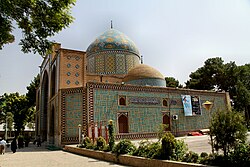You can help expand this article with text translated from the corresponding article in Persian. (June 2022) Click [show] for important translation instructions.
|
Immamzadeh Mahruq (Persian: امامزاده محروق) is an Immamzadeh/mosque and the resting place of Imamzadeh Muhammad Mahruq ibn Muhammad ibn Zayd ibn Ali[1] and Imamzadeh Ibrahim ibn Ahmad ibn Musa al-Kazim situated in Omar Khayyam and Immamzadeh Mohammad Mahruq Garden in Nishapur, Khorasan Province, in northeastern Iran. According to Iranarchpedia[2] the building and the mosque of the Immamzadeh dates back to the Timurid and the Safavid historical era of Persia. This mosque is now registered as part of the Iranian national heritage list with the registration number of 302.[2] Thourghout history, this mosque has been redecorated and reconstructed several times.
| Immamzadeh Mahruq | |
|---|---|
امامزاده محروق | |
 Mosque and the resting place of Immamzadeh Mahruq and Ibrahim | |
 | |
| General information | |
| Status | Open to the public |
| Type | Shia pilgrimage and mosque |
| Architectural style | Persian architecture |
| Location | Nishapur, Razavi Khorasan province, |
| Coordinates | 36°09′54″N 58°49′16″E / 36.165°N 58.821°E |
| Other information | |
| Parking | Available |
| Public transit access | Available |
| Website | |
| neyshabur.ir | |
The current mosque was initially built by the order of Amir Kamal-ol Din during the reign of Sultan Husayn Bayqara. Later and during the Qajar era, this mosque was reconstructed by one of the sons of Fath-Ali Shah Qajar, named Farrokhseyr Mirza 'Nayer od-Doleh'.[3]
In the 20th century, The brickwork of this building was reconstructed and redecorated by Mohammad Hossein Akhavian, a Persian artisan specialized in brickwork who died on January 11, 2020.[4]
Gallery
editReferences
edit- ^ Al-Hakim al-Nishapuri. Shafiei Kadkani, Mohammad-Reza (ed.). History of Nishapur (in Persian). Tehran. p. 211. ISBN 9644160207.
- ^ a b "محمد محروق، امامزاده". Encyclopaedia of Iranian Architectural History. Archived from the original on 2022-09-24. Retrieved 2022-06-05.
- ^ "جلسه: 125 صورت مشروح مجلس پنجشنبه 8 تیر ماه 1306 مطابق سیام ذیحجه 1345". Parliamentary Library of Iran. Archived from the original on 2021-09-26. Retrieved 2022-06-05.
- ^ Eftekhari, Javad (2020-01-11). "اَخَوییان، استاد آجر تراش نیشابوری درگذشت". Iranian Students News Agency. Archived from the original on 2022-06-04. Retrieved 2022-06-05.